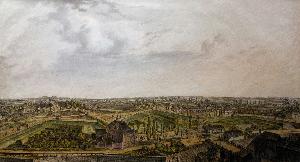Georg Christian Wilder
Georg Christian Wilder;Georg Christoph Wilder
สถานที่: Nuremberg
เกิด: 1797
ความตาย: 1855
ชีวประวัติ:
, also known as Georg Christoph Wilder, was a German painter, copperplate engraver, and architectural draftsman born in Nuremberg, Germany in 1797. He attended St. Lawrence's school and received private teaching from his father.
Early Life and Training
Wilder studied drawing with Gustav Philipp Zwinger and later attended classes with Ambrosius Gabler and Albert Reindel at the Painters' Academy in Nuremberg. In 1817, he participated in an exhibition at the Artists' school. Wilder's first signed etching is dated 1811.
Career and Works
Wilder stayed in Vienna from 1819 to 1832, where he was one of the first painters to discover the romantic aspects of the countryside of Old Nuremberg and Franconian Switzerland. He focused on topographical and colored architectural illustrations, documenting the Nuremberg cityscape at the time of King Ludwig I. Wilder is known for his precise architectural drawings and is considered a pioneer of historic cultural heritage preservation.
Notable Works and Legacy
Some of Wilder's notable works include The City Hall, The Church of St. Lorenz, and The Nuremberg Castle. His works are in the possession of the City of Nuremberg, and can be found at the Germanisches Nationalmuseum and other museums in Germany.
- Georg Christian Wilder's biography on Wikioo.org provides more information about his life and works.
- Visit the Gemäldegalerie Alte Meister to see a comprehensive collection of European paintings from the 15th to the 18th centuries.
- Explore the Hallertorbrücke, Rebuilt in 1697 by Johann Andreas Graff, a renowned German painter and copperplate engraver.
continues to be celebrated through his works, which provide a glimpse into the cultural heritage of Nuremberg and Germany. His contributions to the field of architecture and painting have made him an important figure in the history of art.
Conclusion
In conclusion, Georg Christian Wilder was a talented artist who left a lasting impact on the world of art and architecture. His works continue to be admired and studied by art enthusiasts and historians alike, and his legacy will be remembered for generations to come.

